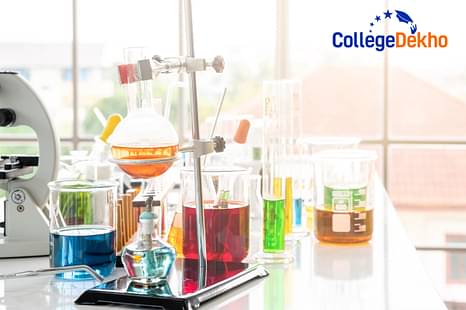p- d- and f-block elements
| -
d-Block elements: General trends in the chemistry of first-row transition elements; Metallic character; Oxidation state; ionization enthalpy; Ionic radii; Color; Catalytic properties; Magnetic properties; Interstitial compounds; Occurrence and extraction of iron, copper, silver, zinc, and mercury; Alloy formation; Steel and some important alloys; preparation and properties of XVII K2Cr2O7, KMnO4.
-
General: Abundance, distribution, physical and chemical properties, isolation and uses of elements; Trends in chemical reactivity of elements of a group; electronic configuration, oxidation states; anomalous properties of the first element of each group.
-
Group 13 elements: Boron; Properties and uses of borax, boric acid, boron hydrides & halides. Reaction of aluminum with acids and alkalis;
-
Group 14 elements: Carbon: carbon catenation, physical & chemical properties, uses, allotropes (graphite, diamond, fullerenes), oxides, halides and sulfides, carbides; Silicon: Silica, silicates, silicone, silicon tetrachloride, Zeolites, and their uses
-
Group 15 elements: Dinitrogen; Preparation, reactivity, and uses of nitrogen; Industrial and biological nitrogen fixation; Compound of nitrogen; Ammonia: Haber’s process, properties and reactions; Oxides of nitrogen and their structures; Properties and Ostwald’s process of nitric acid production; Fertilizers – NPK type; Production of phosphorus; Allotropes of phosphorus; Preparation, structure, and properties of hydrides, oxides, oxoacids (elementary idea only) and halides of phosphorus, phosphine.
-
Group 16 elements: Isolation and chemical reactivity of dioxygen; Acidic, basic and amphoteric oxides; Preparation, structure, and properties of ozone; Allotropes of sulfur; Preparation/production properties and uses of sulfur dioxide and sulphuric acid; Structure and properties of oxides, oxoacids (structures only).
-
Group 17 and Group 18 elements: Structure and properties of hydrides, oxides, oxoacids of halogens (structures only); preparation, properties & uses of chlorine & HCl; Inter halogen compounds; Bleaching Powder; Uses of Group 18 elements, Preparation, structure, and reactions of xenon fluorides, oxides, and oxoacids.
-
Coordination Compounds: Coordination number; Ligands; Werner’s coordination theory; IUPAC nomenclature; Application and importance of coordination compounds (in qualitative analysis, extraction of metals and biological systems e.g. chlorophyll, vitamin B12, and hemoglobin); Bonding: Valence-bond approach, Crystal field theory (qualitative); Isomerism including stereoisomerism.
-
f-Block elements: Lanthanoids and actinoids; Oxidation states and chemical reactivity of lanthanoid compounds; Lanthanide contraction and its consequences, Comparison of actinoids and lanthanoids.
|
Principles of Organic Chemistry and Hydrocarbons
| -
Electronic displacements in a covalent bond: Inductive, resonance effects, and hyperconjugation; free radicals; carbocations, carbanions, nucleophiles, and electrophiles; types of organic reactions, free radial halogenations.
-
Classification: General Introduction, classification based on functional groups, trivial and IUPAC nomenclature. Methods of purification: qualitative and quantitative,
-
Alkenes and alkynes: General methods of preparation and reactions, physical properties, electrophilic and free radical additions, acidic character of alkynes, and (1,2 and 1,4) addition to dienes
-
Alkanes: Structural isomerism, general properties, and chemical reactions, free radical halogenation, combustion, and pyrolysis.
-
Haloalkanes and haloarenes: Physical properties, nomenclature, optical rotation, chemical reactions, and mechanism of substitution reaction. Uses and environmental effects; di, tri, tetrachloromethane, iodoform, freon, and DDT.
-
Aromatic hydrocarbons: Sources; properties; isomerism; resonance delocalization; aromaticity; polynuclear hydrocarbons; IUPAC nomenclature; mechanism of electrophilic substitution reaction, directive influence and effect of substituents on reactivity; carcinogenicity and toxicity.
|
Hydrogen and s-block elements
| -
s-block elements: Abundance and occurrence; Anomalous properties of the first elements in each group; diagonal relationships; trends in the variation of properties (ionization energy, atomic & ionic radii).
-
Alkaline earth metals: Magnesium and calcium: Occurrence, extraction, reactivity and electrode potentials; Reactions with O2, H2O, H2, and halogens; Solubility and thermal stability of oxo salts; Biological importance of Ca and Mg; Preparation, properties and uses of important compounds such as CaO, Ca(OH)2, plaster of Paris, MgSO4, MgCl2, CaCO3, and CaSO4.
-
Hydrogen: Element: unique position in the periodic table, occurrence, isotopes; Dihydrogen: preparation, properties, reactions, and uses; Molecular, saline, ionic, covalent, interstitial hydrides; Water: Properties; Structure and aggregation of water molecules; Heavy water; Hydrogen peroxide: preparation, reaction, structure & use, Hydrogen as a fuel.
-
Alkali metals: Lithium, sodium, and potassium: occurrence, extraction, reactivity, and electrode potentials; Biological importance; Reactions with oxygen, hydrogen, halogens water; Basic nature of oxides and hydroxides; Halides; Properties and uses of compounds such as NaCl, Na2CO3, NaHCO3, NaOH, KCl, and KOH.
|
Chemical Kinetics
| -
Factors Affecting the Rate of the Reactions: Concentration of the reactants, catalyst; the size of particles, the Temperature dependence of rate constant concept of collision theory (elementary idea, no mathematical treatment); Activation energy.
-
Aspects of Kinetics: Rate and Rate expression of a reaction; Rate constant; Order and molecularity of the reaction; Integrated rate expressions and half-life for zero and first-order reactions.
-
Surface Chemistry: Adsorption – physisorption and chemisorption; factors affecting adsorption of gasses on solids; catalysis: homogeneous and heterogeneous, activity and selectivity: enzyme catalysis, colloidal state: distinction between true solutions, colloids and suspensions; lyophilic, lyophobic multimolecular and macromolecular colloids; properties of colloids; Tyndall effect, Brownian movement, electrophoresis, coagulations; emulsions–types of emulsions.
|
Physical and Chemical Equilibrium
| -
Concentration Units: Mole Fraction, Molarity, and Molality
-
Chemical Equilibria: Equilibrium constants (KP, KC), Factors affecting equilibrium, LeChatelier’s principle.
-
Physical Equilibrium: Equilibria involving physical changes (solid-liquid, liquid-gas, solid-gas), Surface chemistry, Adsorption, Physical and Chemical adsorption, Langmuir Isotherm, Colloids and emulsion, classification, preparation, uses.
-
Solutions: Solubility of solids and gases in liquids, Vapour Pressure, Raoult’s law, Relative lowering of vapor pressure, depression in freezing point; elevation in boiling point; osmotic pressure, determination of molecular mass; solid solutions, abnormal molecular mass, van’t a Hoff factor. Equilibrium: Dynamic nature of equilibrium, the law of mass action
-
Factors Affecting Equilibria: Concentration, Temperature, Pressure, Catalysts, Significance of G and G 0 in Chemical Equilibria.
-
Ionic Equilibria: Strong and Weak electrolytes, Acids, and Bases (Arrhenius, Lewis, Lowry, and Bronsted) and their dissociation; degree of ionization, Ionization of Water; ionization of polybasic acids, pH; Buffer solutions; Henderson equation, Acid-base titrations; Hydrolysis; Solubility Product of Sparingly Soluble Salts; Common Ion Effect.
|
Electrochemistry
| -
Electrolytic Conduction: Electrolytic Conductance; Specific and molar conductivities; variations of conductivity with concentration, Kolhrausch’s Law and its application, Electrolysis, Faraday’s laws of electrolysis; Electrode potential and electrolysis, Commercial production of the chemicals, NaOH, Na, Al.
-
Redox Reactions: Oxidation-reduction reactions (electron transfer concept); Oxidation number; Balancing of redox reactions; Electrochemical cells and cell reactions; Standard electrode potentials; EMF of Galvanic cells; Nernst equation; Factors affecting the electrode potential; Gibbs energy change and cell potential; Secondary cells; dry cells, Fuel cells; Corrosion and its prevention.
|
Thermodynamics
| -
Basic Concepts: Systems and surroundings; State functions; Intensive & Extensive Properties; Zeroth Law and Temperature
-
Second Law: Spontaneous and reversible processes; entropy; Gibbs free energy related to spontaneity and non-spontaneity, non-mechanical work; Standard free energies of formation, free energy change, and chemical equilibrium
-
First Law of Thermodynamics: Work, internal energy, heat, enthalpy, heat capacities, and specific heats, measurements of ∆U and ∆H, Enthalpies of formation, phase transformation, ionization, electron gain; Thermochemistry; Hess’s Law, Enthalpy of bond dissociation, combustion, atomization, sublimation, solution and dilution
-
Third Law: Introduction
|
Chemical Bonding & Molecular Structure
| -
Dipole moments; Hydrogen Bond.
-
Molecular Structure: Lewis picture & resonance structures, VSEPR model & molecular shapes
-
Valence electrons, Ionic Bond: Lattice Energy and Born-Haber cycle; Covalent character of ionic bonds and polar character of covalent bond, bond parameters.
-
Covalent Bond: Valence Bond Theory- Orbital overlap, Directionality of bonds & hybridization (s, p & d orbitals only), Resonance; Molecular orbital theory- Methodology, Orbital energy level diagram, Bond order, Magnetic properties for homonuclear diatomic species (qualitative idea only).
|
Atomic Structure
| -
Quantum mechanics: Wave-particle duality – de Broglie relation, Uncertainty principle; Hydrogen atom: Quantum numbers and wavefunctions, atomic orbitals and their shapes (s, p, and d), Spin quantum number.
-
Introduction: Subatomic particles; Atomic number, isotopes and isobars, Thompson’s model and its limitations, Rutherford’s picture of the atom and its limitations; Hydrogen atom spectrum and Bohr model and its limitations.
-
Periodicity: Brief history of the development of periodic tables Periodic law and the modern periodic table; Types of elements: s, p, d, and f blocks; Periodic trends: ionization energy, atomic, and ionic radii, inter gas radii, electron affinity, electro negativity, and valency. Nomenclature of elements with atomic number greater than 100.
-
Many electron atoms: Pauli exclusion principle; Aufbau principle and the electronic configuration of atoms, Hund’s rule.
|
States of Matter
| -
Chemical reactions: Laws of chemical combination, Dalton’s atomic theory; Mole concept; Atomic, molecular, and molar masses; Percentage composition empirical & molecular formula; Balanced chemical equations & stoichiometry
-
Measurement: Physical quantities and SI units, Dimensional analysis, Precision, Significant figures.
-
Liquid state: Vapour pressure, surface tension, viscosity.
-
Solid state: Classification; Space lattices & crystal systems; Unit cell in two-dimensional and three-dimensional lattices, calculation of density of unit cell – Cubic & hexagonal systems; Close packing; Crystal structures: Simple AB and AB2 type ionic crystals, covalent crystals – diamond & graphite, metals. Voids, number of atoms per unit cell in a cubic unit cell, Point defects, non-stoichiometric crystals; Electrical, magnetic, and dielectric properties; Amorphous solids – qualitative description. Band theory of metals, conductors, semiconductors, and insulators, and n- and p-type semiconductors.
-
Three states of matter, intermolecular interactions, types of bonding, melting and boiling points Gaseous state: Gas Laws, ideal behavior, ideal gas equation, empirical derivation of gas equation, Avogadro number, Deviation from ideal behavior – Critical temperature, Liquefaction of gases, van der Waals equation.
|
Stereochemistry
| -
General: Nomenclature, electronic structure, important methods of preparation, identification, important reactions, physical and chemical properties, uses of alcohols, phenols, ethers, aldehydes, ketones, carboxylic acids, nitro compounds, amines, diazonium salts, cyanides, and isocyanides.
-
Conformations: Ethane conformations; Newman and Sawhorse projections.
-
Geometrical isomerism in alkenes
-
Specific: Reactivity of -hydrogen in carbonyl compounds, the effect of substituents on alpha-carbon on acid strength, comparative reactivity of acid derivatives, mechanism of nucleophilic addition and dehydration, the basic character of amines, methods of preparation, and their separation, the importance of diazonium salts in synthetic organic chemistry.
-
Organic Compounds with Functional Groups Containing Oxygen and Nitrogen
|
Theoretical Principles of Experimental Chemistry
| -
Qualitative analysis of Inorganic Salts: Principles in the determination of the cations Pb2+, Cu2+, As3+, Mn2+, Al3+, Zn2+, Co2+, Ca2+, Sr2+, Ba2+, Mg2+, NH4 +, Fe3+, Ni2+ and the anions CO3 2-, S2-, SO4 2-, SO3 2-, NO2 - NO3 -, Cl-, Br-, I-, PO4 3-, CH3COO-, C2O4 2-
-
Volumetric Analysis: Principles; Standard solutions of sodium carbonate and oxalic acid; Acid-base titrations; Redox reactions involving KI, H2SO4, Na2SO3, Na2S2O3, and H2S; Potassium permanganate in acidic, basic and neutral media; Titrations of oxalic acid, ferrous ammonium sulfate with KMnO4, K2 Cr2O7/Na2S2O3, Cu(II)/Na2S2O3.
-
Purification Methods: Filtration, crystallization, sublimation, distillation, differential extraction, and chromatography. Principles of melting point and boiling point determination; principles of paper chromatographic separation – Rf values.
-
Qualitative Analysis of Organic Compounds: Detection of nitrogen, sulfur, phosphorous, and halogens; Detection of carbohydrates, fats, and proteins in foodstuff; Detection of alcoholic, phenolic, aldehydic, ketonic, carboxylic, amino groups, and unsaturation.
-
Physical Chemistry Experiments: preparation and crystallization of alum, copper sulfate. Benzoic acid ferrous sulfate, double salt of alum and ferrous sulfate, potassium ferric sulfate; Temperature vs. solubility; Study of pH charges by common ion effect in case of weak acids and weak bases; pH measurements of some solutions obtained from fruit juices, solutions of known and varied concentrations of acids, bases and salts using pH paper or universal indicator; Lyophilic and lyophobic sols; Dialysis; Role of emulsifying agents in emulsification. Equilibrium studies involving ferric and thiocyanate ions (ii) [Co(H2O)6] 2+ and chloride ions; Enthalpy determination for strong acid vs. strong base neutralization reaction (ii) hydrogen bonding interaction between acetone and chloroform; Rates of the reaction between (i) sodium thiosulphate and hydrochloric acid, (ii) potassium iodate and sodium sulfite (iii) iodide vs. hydrogen peroxide, concentration and temperature effects in these reactions
-
Principles of Organic Chemistry Experiments: Preparation of iodoform, acetanilide, p-nitro acetanilide, di-benzyl acetone, aniline yellow, beta-naphthol; Preparation of acetylene and study of its acidic character.
-
Quantitative Analysis of Organic Compounds: Basic principles for the quantitative estimation of carbon, hydrogen, nitrogen, halogen, sulfur, and phosphorous; Molecular mass determination by silver salt and chloroplatinate salt methods; Calculations of empirical and molecular formulae
-
Basic Laboratory Technique: Cutting glass tube and glass rod, bending a glass tube, drawing out a glass jet, boring of cork.
|


















Similar Articles
Gujarat Polytechnic Admission 2024: Final Seat Allotment (Available), Dates, Counselling Process, Registration, Eligibility
JoSAA Round 5 IIT Cutoff 2024: Check Opening & Closing Ranks
List of Colleges for 80,000 to 1,00,000 Rank in AP EAMCET 2024
List of Colleges for 50,000 to 75,000 Rank in AP EAPCET (EAMCET)
List of Colleges for 25,000 to 50,000 Rank in AP EAMCET 2024
List of B.Tech CSE Colleges Accepting 10,000 to 25,000 Rank in AP EAMCET 2024